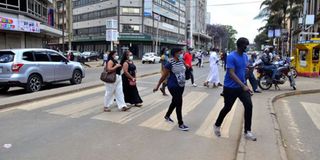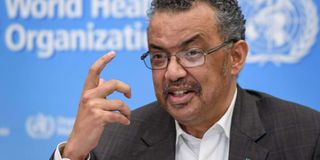Premium
Covid-19: Why we're likely riding a second, deadlier wave

City residents at a zebra crossing along Moi Avenue on October 16, 2020.
In each of his Covid-19 addresses to Kenyans since March, Health Cabinet Secretary Mutahi Kagwe has consistently maintained his serious tone and body language.
Without losing a beat, CS Kagwe has reminded Kenyans for seven months to continue wearing masks, washing hands, sanitising and observing social distancing rules.
However, it’s a different story with the intended recipients of his message. Adherence to Covid-19 containment measures has slackened as Kenyans now go about their lives as though there were no pandemic in our midst.
Last week, Kagwe warned that Kenya could be staring at a second wave of the virus, whose severity will be more lethal.

Health Cabinet Secretary Mutahi Kagwe addresses a press conference at Afya House in Nairobi on October 18, 2020, on the Covid-19 pandemic in Kenya.
With cases rising sharply in recent weeks, it would appear that this dreadful reality has already caught up with us.
So why would a second wave of the virus be more widespread and deadlier?
Testing has been sluggish
Eight months into the pandemic, less than 700,000 people have been tested in the country. There are several reasons for this ranging from shortage of testing kits to prohibitive testing costs. The key takeaway to note is that many Kenyans are yet to undergo a Covid-19 test. This is worrying when you consider that most confirmed Covid-19 cases in Kenya have been found to be asymptomatic.
Experts argue that the relatively small tally of confirmed cases could be attributable to low testing levels.
Elsewhere in the world, authorities have put emphasis on mass testing to determine actual infection rates. It’s through testing that the virus is contained by isolating patients and treating them.
With sluggish testing levels, Kenya runs the risk of catastrophic infections in a second wave.
Initial fear of virus has faded
When the coronavirus pandemic started, Kenyans lived in dread of contracting the virus. Its mention inspired crippling anxiety among Kenyans. Today, that’s no longer the case.
Fewer and fewer people wear masks, adhere to social distancing rules while handwashing and sanitising have been relegated to the backburner.
Players in the public transport sector are already asking to be allowed to carry passengers at full capacity, while some matatus in Nairobi have taken the liberty to resume normal operations.
Additionally, Kenyans are thronging clubs and other entertainment joints, indicating that to them, life is back to normal.

Inside B-Club at Kilimani, Nairobi on October 13, 2020.
Difficulties in contact tracing
Contact tracing is the surest way to arrest the spread of the virus, according to experts. At this stage in the fight against the pandemic though, this exercise would be a Herculean task. The majority of Kenyans may have come into contact with someone who has been infected, either directly or indirectly.
This way, tracing all the people one has interacted with would be more complicated, thus fuelling more infections.
Kenya barely contained the first round of virus.
When Covid-19 cases kept rising between April and August, Kenyan hospitals were overwhelmed, as the government advised people to self-isolate at home. Notably, the majority of the 49,000 Kenyans who have tested positive for the virus have been taken care of at home. Even so, hospitals were stretched beyond capacity.
As of last week, Kenya had only 18,443 isolation beds, 12,000 short of the target, according to the Kenya Medical Pharmacists and Dentists Council (KPMDC).
The situation is even more telling in counties where some devolved units are yet to attain the 300 bed capacity more than three months since President Kenyatta directed county heads to boost preparedness at the local level.
Already, local hospitals can’t admit Covid-19 in-patients, for lack of capacity.
Audacious return of political activity
For months between March and August, political activity in the country ground to a halt. Rallies were banned and gatherings of more than 15 people were not allowed.
Now, it feels like nothing has changed. Political rallies are back in full force, especially as the BBI push hits a crescendo.
Political gatherings, led by none other than President Uhuru Kenyatta and his deputy William Ruto and ODM leader Raila Odinga, are attended by multitudes who barely have masks and rarely observe social distancing.

President Uhuru Kenyatta greets city residents who had gathered outside Pumwani Social Hall on October 23, 2020 after he met members of the Boda Boda Safety Association of Kenya.

Wiper Party leader Kalonzo Musyoka addresses a crowd at Malili Shopping Centre on his way from the Konza Technopolis City on September 25, 2020.
Leaders are also openly shaking hands with each other and sometimes, their supporters, in outright defiance of Ministry of Health guidelines.
While the politicians are risking their personal health, they're also putting hundreds and possibly thousands at risk of infection too.
Mutation of the virus
Medical experts are on the edge. Over the last few months, it has emerged that the virus could possibly mutate. Hardly much is known about the first strain of Covid-19 that has claimed millions of lives around the world, as well as devastating healthcare systems and crippling economies.
A second strain would be even more disastrous and could force governments back to the drawing board.
Harder to curb movement and interactions
At this rate, the spread of the virus can’t controlled without dire economic consequences. Business may have been allowed to reopen and travel resumed. These though seem to be the weak links in fight against the virus.
To stop a potential second wave would mean more stringent rules on interactions and movement, translating to more severe income losses, slow business activity and a longer recovery timeline.
Herd immunity won't help
The way viruses work is that the more people are infected, the higher the number of those who develop immunity against reinfection. This curtails its circulation and, therefore, prevents those who haven’t been infected from contracting it. This is known as herd immunity.
However, the head of the World Health Organization (WHO), Tedros Ghebreyesus, has ruled out herd immunity as a viable response to the pandemic. This is because herd immunity is achieved by protecting people from a virus, and usually works where there's already a vaccine, and not by simply exposing them to it.
"Never in the history of public health has herd immunity been used as a strategy for responding to an outbreak, let alone a pandemic," he said recently.

With less than 50,000 confirmed cases in Kenya and about 36,000 recoveries, it appears that only a fraction of Kenyans got the virus.
Compared to elsewhere in the world, Kenya and many African countries may have largely avoided the destruction wrought by Covid-19. For now.
"Letting Covid-19 circulate unchecked therefore means allowing unnecessary infections, suffering and death," Ghebreyesus said.
Possible reinfection
In April, the WHO warned that there was no evidence that people who have recovered from the virus were immune to new infection. As such, it would be disastrous to have reinfections on top of surging infections in the country.
But where are we at the moment? Is Kenya staring at a second wave or are we still in the first round of infections?
American infectious diseases expert Dr Anthony Fauci says that for the first wave of the disease to be declared over, numbers have to come down to single digits.
In Kenya, numbers have been erratic: they rose, fell sharply then started to rise again.
During an interview in August, infectious diseases expert and University of Nairobi lecturer Dr Loice Ombajo said that Kenya may have peaked between late July and early August when the number of daily infections rose to between 400 and 800.
As cases continue to rise toward the end of October, health experts are forced to go back to the drawing board to draft strategies for curbing a potential second implosion of the virus. For countries that haven’t experienced a second wave of the virus, global health experts insist that they should keep it at bay at all costs until a vaccine is found.
There is also fear among medics worldwide of a possible return of the virus or a new strain in November and December, months when many people catch flu.
According to doctors, fighting flu during a pandemic would pose difficulties and strain resources and personnel. It would be even more devastating in a country such as Kenya where the level of preparedness to deal with a full-blown viral explosion has so far proven unsatisfactory.
Will Kenya weather a second wave? We'll know soon enough.




